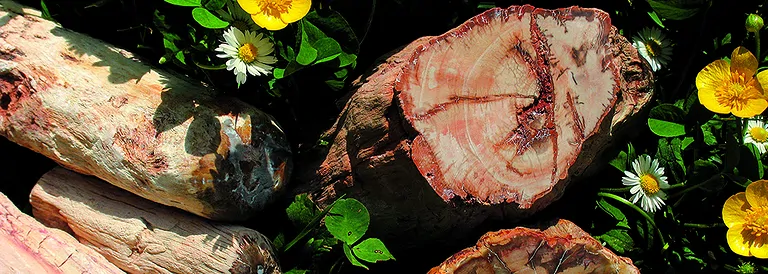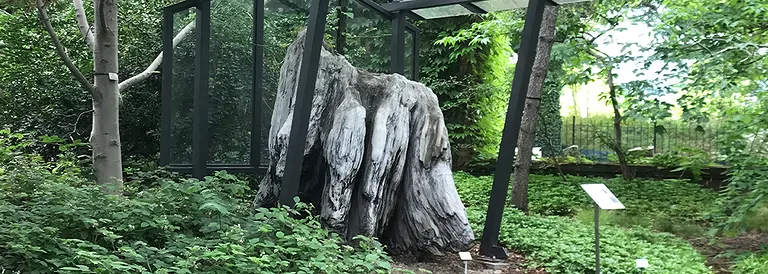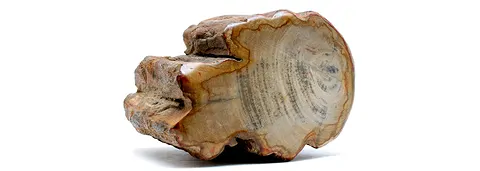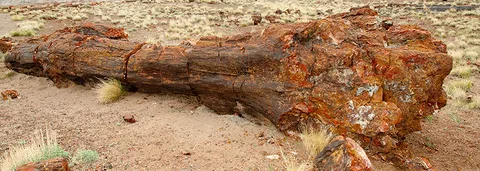
Petrified Wood - bearing, effect and application of a fossile gemstone
Petrified Wood makes grounded and helps not to lose one's touch with reality in turbulent times. Stable and firmly anchored in ones own being, it's possible to contentedly enjoy what have been achieved. The connection to the own base, to the roots of one's being us strengthened. Developments that have been started can be completed with the support of the petrified wood.
Mineralogical profile od petrified wood
Chemical formula, mineral class: SiO2 + C,Fe,K,Na,O,OH - mineral class of oxides
Formation: Secondary; minerals are formed in the cells of the wood, which maintain the structure of the wood, while the organic matter decays. This requires rapid closure from atmospheric oxygen through sediment cover.
Color: red, yellow, brown, gray to black; depending on the intercalation of other minerals. The most common here are Apatite, Calcite, Chalcedony, Dolomite, Fluorite, Galena, Hematite, Pyrite and Opal.
Transparency, luster: opaque, matte, polished it shows vitreous luster
Crystal system: mostly trigonal quartz, rarely amorphous opal
Mohs hardness: 6.5 - 7
Cleavability, fracture: none; uneven, splintery fracture
Appearance: Appearance determines the original structure of the wood. Coniferous woods show monotonous cellular tissue; the basic tissue of hardwoods is pierced by larger holes, original water conduction channels; palm wood shows fine darker pores due to the parallel conductive bundles.
Age: Depending on where it was found, petrified wood ranges from 2 to 25 million years old (Indonesia) to 250 million years old (Arizona, Madagascar)

Petrified Wood from Saxony in the Botanical Garden Dresden
Localities and countries of origin for fossilized wood
Petrified Wood is found in many areas of the world. Very well known is the UNESCO World Heritage Site "Petrified Forest National Park" in the USA with its fantastic large tree trunks. In the "petrified forest" between Holbrook and Navajo you can find up to 65m long and 3m thick fossilized Araucaria. The items on sale are mainly made of Petrified Wood from Madagascar; in recent years, products from Indonesia have also been found.
Also in Germany there are numerous sites for Petrified Wood, especially in Saxony. For jewelry making, the Zwenkau druse wood is very popular - silicified redwood from the Eocene, which was found in individual Layers of the lignite open pit mine was found. In the meantime, the sites, which were also of great interest to paleo-botanists, have been flooded and now serve as a recreational area along with Lake Cospuden and Lake Zwenkau.
In the Dresden Botanical Garden, there is an impressive witness to the end of the Permian geological era. About 291 million years ago, a series of volcanic eruptions abruptly ended all life in the area where the city of Chemnitz is located today. Silica and fluorite in particular were incorporated into the tree trunks, so that the impressive plant remains of the "Fossilized Forest of Chemnitz" have survived to this day. Unfortunately, it is no longer possible to identify exactly to which species the then living trees belong, since little of the structure of the wood has been preserved at this site.
Origin of the name petrified wood and synonyms
Petrified Wood is named after the way it was formed. Depending on whether the organic wood substance has been replaced by quartz or opal, it is referred to as quartzized or opalized wood.
Synonyms include tree quartz, wood agate, woodstone, siliceous wood, silicified wood, petrified palm wood, and xylolite. Dendrolite, dendrolite, tree stone, as well as woodstone are also found as names for petrified wood.
For opalized wood, tree opal, wood opal, lithoxyl and lithoxylon are other names. There are also some synonyms for petrified tree fern: Eye Care Stones, Asterolite, Starry-Stone, Starstone, as well as Peanut-Wood (misleading!).

Beautifully recognizable annual rings
History and use of petrified wood
In the temples of the Etruscans, Petrified Wood was already used more than 4000 years ago. At that time it was thought to be bones of the gods; one reason why it was considered a sanctuary at that time. There was a belief that Petrified Wood helps to remember a past life.
For botanical research, Petrified Wood makes a valuable contribution, as well-preserved pieces can be used to reconstruct the vegetation of past geological eras. Furthermore, Petrified Wood is valuable as a collector's item, as well as for the manufacture of arts and crafts and exclusive pieces of furniture of importance. Petrified Wood has also gained a firm place in modern stone medicine due to its grounding effect.

Fossilized log Petrified Forest National Park (USA)
For retailer: huge assortement of petrified wood items at wholesale prices
Applications of petrified wood in gemstone healing
"Grounding" is the key word for the properties of Petrified Wood. Groundedness and a sense of reality are encouraged. It is helpful when one tends to lose oneself in thought, digress without concentration, or leave unfinished what has been begun unfinished. Petrified Wood has a restorative, centering and gathering effect. It encourages taking time for leisure and reflection. For beginners, it is an excellent meditation aid. Because of its grounding properties is petrified Wood is a component of waterstone blends.
Chakras and Astrology
Petrified Wood is associated with the first, root chakra. Astrologically, it fits the signs of Gemini and Leo.